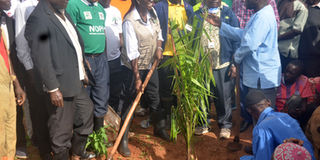Prime
Busoga farmers abandon sugarcane, opt for oil palm

The manager of National Oil Palm Project, Ms Susan Lakwonyero (centre), commissions the growing of the crop in Mayuge District last week. PHOTO | TAUSI NAKATO
What you need to know:
- Oil palm is harvested twice a month compared to sugarcane which is done once a year.
The fluctuation of sugarcane prices in the Busoga Sub-region has compelled farmers to abandon the crop for oil palm growing.
Currently, a tonne of sugarcane costs Shs150,000 down from Shs240,000 in December 2023.
The focal person of the National Oil Palm Project for Mayuge District Hub, Mr Thomas Aram, said currently 4,000 farmers have resorted to oil palm farming.
Mr Aram said so far, 7,000 acres have been allocated by farmers for the oil palm project.
“Of the 7,000 acres which have been pledged, we have so far surveyed 3,500 acres in all the sub-counties of Mayuge District,’’ he said.
The chairperson of Mayuge District Oil Palm Growing Cooperative Society Limited, Mr Moses Mabanda, said oil palm is harvested twice a month compared to sugarcane which is done once a year.
“You grow it once and spend 30 years without growing it again and you harvest twice a month, it has a ready market compared to sugarcane,’’ he said.
Ms Loy Nakaziba, another oil palm farmer said, the crop allows intercropping compared to sugarcane.
“I have abandoned sugarcane growing because it has left us without food. You cannot mix sugarcane with another food crop but with oil palm growing, you can grow food crops on the same piece of land,’’ he said.
Mr Mwahamadi Gweru, a farmer at Buwolya Village in Buwaaya Sub-county, Mayuge District, said: “I have been a sugarcane grower but cases of fire gutting sugarcane have been rampant unlike with growing oil palm. Cases of theft are also rampant in sugarcane plantations.’’
Mr Gweru said he has allocated four out of 10 acres of his land for oil palm growing.
Mr Ali Kibwika Isabirye, a new oil palm farmer, said: “I have over 10 acres but I could get Shs1m in a month, even in a year in sugarcane growing because a kilogramme costs Shs160. Palm oil is a big investment even if I die now, my children will not sell the land because they will get continuous profits.’’
Mr Charles Ssembatya, the project agronomist for the National oil palm Project under the Agriculture ministry, said they have selected three districts in Busoga that are favourable for oil palm growing.
“We have selected Mayuge, Namayingo and Bugiri which are near the shores of Lake Victoria because the soil is fertile and the climatic conditions are similar to those of Rakai and Buvuma where the project started,’’ he said.
Mr Ssembatya revealed that research conducted in West Africa, Malaysia, and Indonesia, indicated that oil palm is key in boosting family incomes.
“ We have identified oil palm as a crop that can alleviate people out of poverty in Busoga. A farmer can collect Shs500,000 in an acre every month, that is Shs2.5m in five acres every month. The production continues up to 25 years compared to other crops such as sugarcane that you harvest twice every two years,’’ he said.
Mr Ssembatya added that they have provided seedlings to farmers on loan repayable after four years.
Pricing formula
Speaking during the commissioning of the oil palm growing at Buwolya Muslim Primary School in Mayuge District at the weekend, Ms Susan Lakwonyero, the National Oil Palm Project manager, said farmers will enjoy stable prices of palm oil.
“We have a pricing formula which caters to all the costs that are required. It caters to the costs of flight which are added on by farmers. We have a pricing committee composed of farmers and government officials,’’ he said.
Ms Lakwonyero said oil palm growing in Busoga will reduce the $300m, the country spends every year on importation of raw materials for making soap and other-related products.
“We can produce locally the raw material because the environment is conducive instead of importing them from Malaysia and Indonesia every year,’’ she said.
Ms Lakwonyero said they would establish a mill in the Mayuge to provide a ready market for palm oil. According to a 2019/2020 report released by the Uganda Bureau of Statistics, Busoga was ranked the poorest sub-region.
Background
In 2019, the International Fund for Agricultural Development (IFAD), agreed with the government through the Finance and Agricultural ministries to support the extension of oil palm growing to several other districts and inject Shs767b into the project. The districts include Buvuma, Mayuge, Masaka, Kyotera, Buikwe, and Mukono.




